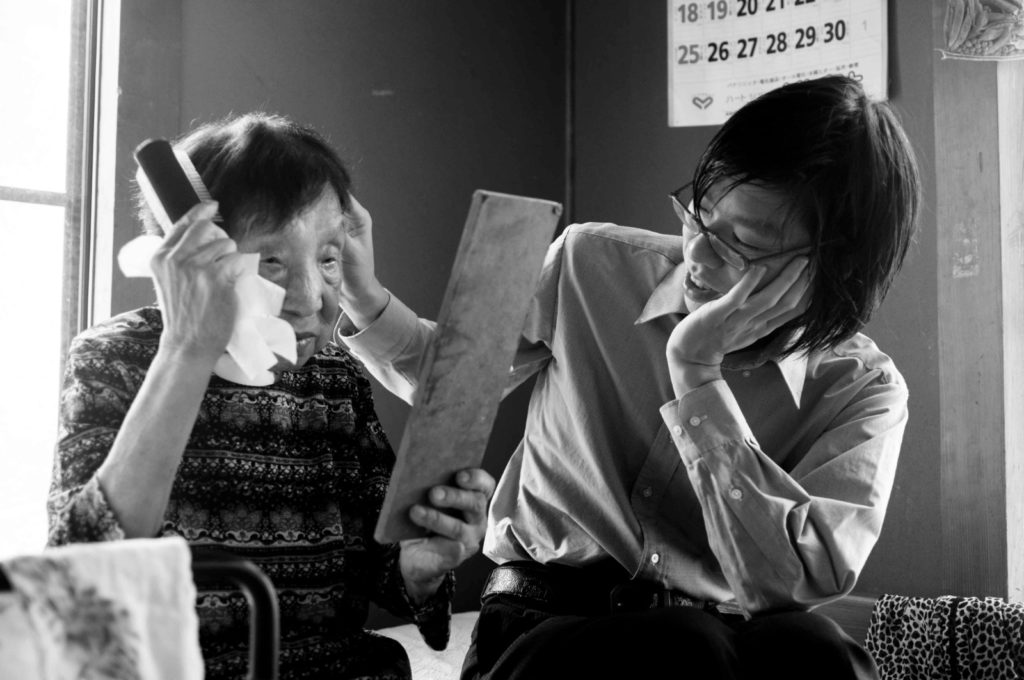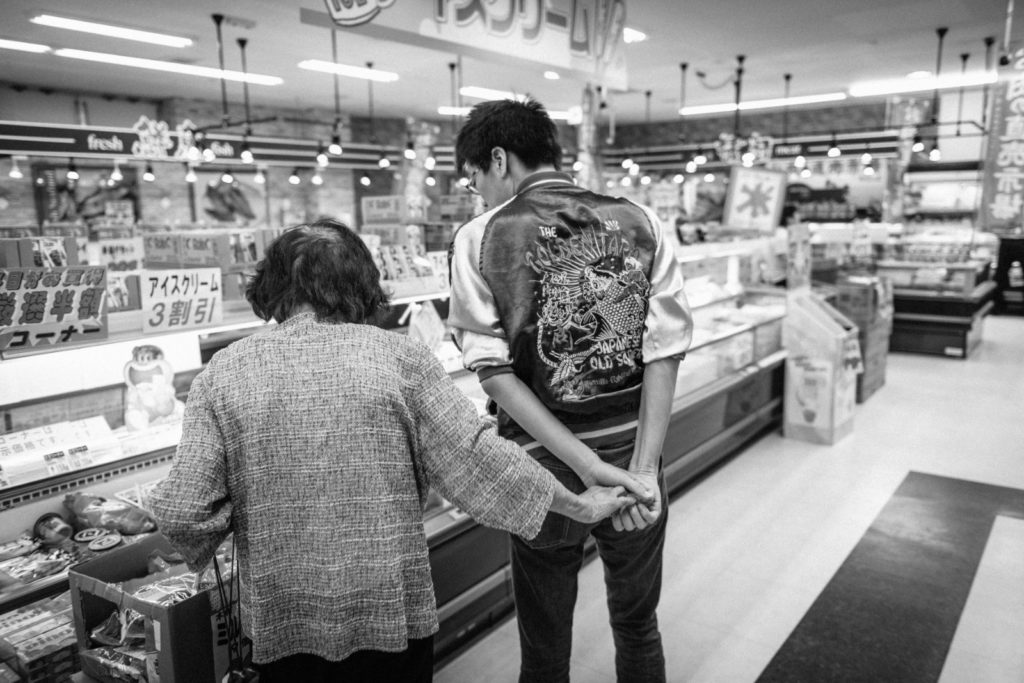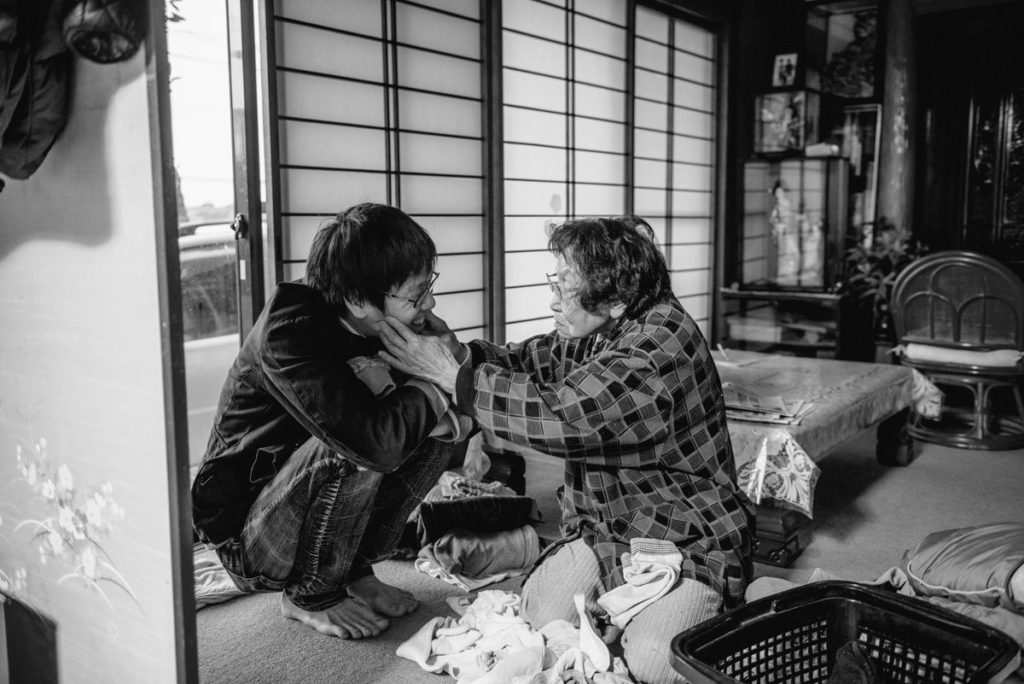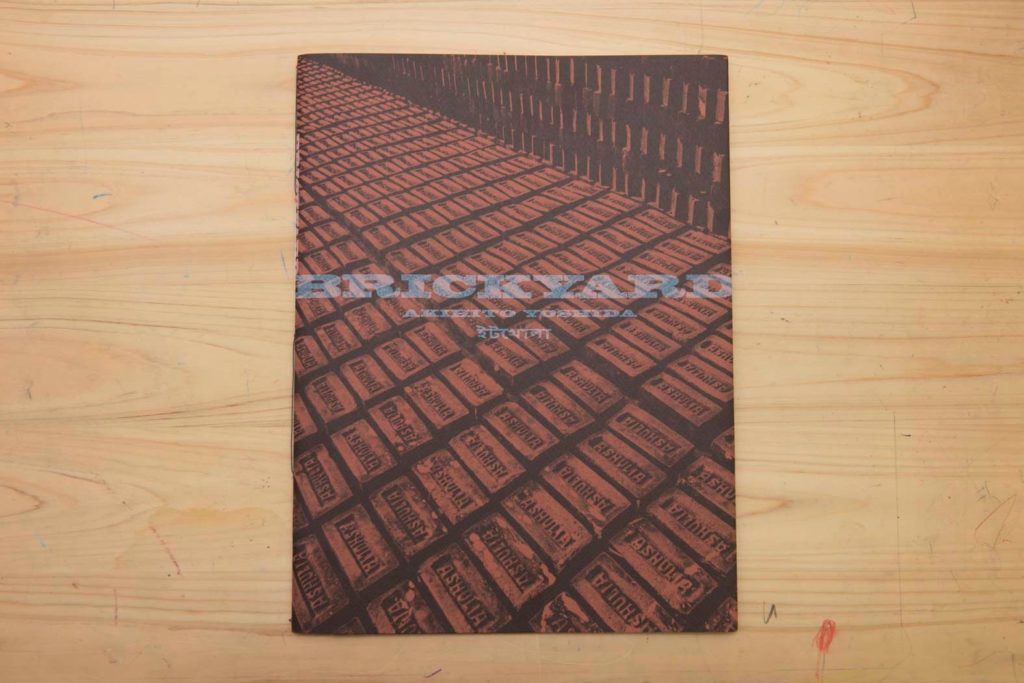Akihito Yoshida (b.1980) is a Japanese photographer living in Kyoto. After having been a teacher for six years, Yoshida begins a career as a documentary photographer in 2010. His work received the Nikkei National Geographic Photography Award for People in 2016 and was exhibited at Kyotography in 2017, one of Japan’s most influential fair dedicated to contemporary photography, giving him a certain recognition. He independently published three books : Brick Yard in 2014 – documenting the work of seasonal workers in a brickworks – Tannery in 2016 – illustrating the hardness of the work in a tannery in Bangladesh – and Falling Leaves in 2017 telling the story of his grandmother and his cousin Daiki. This series was exhibited at the beginning of 2020 at the Fisheye Gallery in Paris entitled « The Absence of Two ».

ACA project : Could you tell us a bit more about your career : When and how did you begin doing photography?
Akihito Yoshida : I begun my career as a photographer ten years ago in 2010, I was 30 years old. Before that, I worked as a teacher for six years. I also got married and my first daughter was born. My life was pretty stable but one day my wife told me : « I want you to resign from your job. » In Japan, being a teacher is a pretty difficult job even if the salary is stable and the social status secure. My wife is also a teacher, she thought our family doesn’t need two civil servants. To her point of view, as a parent we have to show your children the way so that they can find their own. That is why she told me : « I think it is important to show our children another way of life. I want you to quit the university and find a new path. » At the beginning, I didn’t really understood what she meant. I didn’t think she was wrong either. After some time, I decided to stop my career as a teacher but I didn’t know what to do. My wife told me : « You are going to be a photographer. » I didn’t know why she told me that. I used to do photography when I was in college but I was only taking photos of my family. However I heard her advices and decided to begin a career as a photographer.
ACA project : Do you have a degree in photography ? If not, how did you learn it?
AS : As I said before, I am a self-taught photographer. I never studied photography. The first thing I did when I begun my career as a photographer was to look at photographies, any kind of photographies, from everywhere, from the beginning of photography until today. Thanks to that, I kind of absorbed the essence of the photos and the books : the themes, compositions, conceptions. It helped me develop my thoughts on photography and on the way to express them in my work. Ten years after, I am still learning every day.
ACA project : Which concepts lead your reflexion and work ?
AS : There is a common concept to all of my artworks, they all are influenced by my personal experiences. In each artwork, I try to look and analyze the events and problems I encounter in my daily life. They nourish my work. And vice versa, I couldn’t create if I had no problem nor personal implication. To end properly each series, I like to compile the materials in a book.
ACA project : Which photographers or artists have an influence on your work ?
Nobuyoshi Araki is the photographer who had the biggest influence on my work. Even if he produced many amazing work such as « Sentimental Journey / Winter Journey », he mostly influenced me through his theory of photography, his production method and his position towards production. I was also very much influenced by the two film directors Lee Chang-Dong and Aki Kaurismäki. They both have in common to use narration in order to carrefully collect and reveal the lives of people at the edges of society and that none really see. When I work, I always have in mind the photography in their movies.
ACA project : You have lived abroad, which impact did it have on your work ?
AS : I think it had a great influence on me. When I was 23 I lived in a poor rural city in the north-east of Thailand. I spent a year there teaching Japanese to local college students. Thailand is a country where the LGBT community has been well integrated in the society for a long time. Many students I met at the university belonged to this community. It was very surprising for me at that time. As you may know, Japan is a country where diversity is not something we often talk about. I don’t know where this comes from, maybe the fact that Japan is an island with a strong ethnic unity. For me, born and raised in this kind of country, living in Thailand taught me a lot. It made me realize that things aren’t the same everywhere but quite the contrary, diverse and rich. I think this experience gave me the opportunity to become a photographer that collects and shows a wide range of ideas from all over the world as an ongoing project.

ACA project : How did you begin your project « The Absence of Two »?
AS : In 2011, right after beginning my career as a photographer, I came back to my hometown Miyazaki and visited my grandmother. I took some photographs of my grandmother and my cousin Daiki, who was living with her, as a memory. A few days after, I went back to Kyoto, where I live. Once in Kyoto, I looked again at the photographs I had taken in Myazaki and one especially gave me a unusual feeling – the one where my grandmother is holding a mirror, combing her hair, his grandchild looking affectionately at her. I felt something more than a common relationship between a grandmother and her grandchild, as if they were mother and child, lovers, as a couple with me for many years, as two old friends. Looking at those photographs changed the perception I had of them before. I was fascinated by the new relationship between them that I was discovering. That is how I started the project « The Absence of Two ».
ACA project : What are your upcoming projects?
AS: We are currently working on three major projects. The first one is the second part of « The Absence of Two ». It is a summary of the two years from the passing of Daiki to the death of my grandmother. This work is based on a story embodying the loss and hope my grandmother told me. It already has been published as a photobook.
The second project is a work on end-of-life care. The report takes place in Japan and Hong Kong, two developed countries where the society is aging. We are currently doing some photography researches focusing on old people and adopting a medical and religious perspective.
Finally the third project is focusing on the story of a young boy, working as a bus driver in Bangladesh. I begun this work four years ago. He was fifteen years old at that time, he is now nineteen. With this series, I would like to present the locals with a new way, different from the usual display in a museum. I would like to exhibit the series in a lively place of the locals such as the bus where the young boy is working in. I also would like to merge in a book the creation process of the exhibition with the photographs and texts.
Interview by Camille Despré, 2020 – Translation from Japanese with the help of Shoko Hayashi

Akihito Yoshida (né en 1980) est un photographe japonais travaillant à Kyoto. Après avoir été enseignant, il commence une carrière de photographe documentaire en 2010. Son travail a reçu en 2016 le prix Nikkei National Geographic Photography Award for People. En 2017, il expose à Kyotographie, l’un des festivals majeurs de photographie au Japon, sa série Falling Leaves, lui permettant d’accéder à une certaine reconnaissance. Il a publié trois livres de manière indépendante : Brick Yard en 2014 – documentant le travail de travailleurs saisonniers dans une briqueterie -, Tannery en 2016 – illustrant la difficulté du travail dans une tannerie au Bangladesh – et Falling Leaves en 2017 racontant la relation de sa grand-mère et de son cousin Daiki. Cette série a été exposée début 2020 à la Fisheye Gallery à Paris sous le titre « The Absence of Two ».
ACA project : Pouvez-vous nous parler un peu de votre carrière : quand et comment avez-vous commencé la photographie ?
Akihito Yoshida : Je suis devenu photographe il y a 10 ans en 2010. J’avais alors 30 ans. Auparavant, j’avais travaillé comme instituteur pendant six ans. Au cours de ces six années, je me suis marié, ma fille aînée est née et j’ai eu une vie agréable. Mais un jour, ma femme m’a soudainement dit: « Je veux que tu quittes ton travail. » Au Japon, le travail d’enseignant est difficile, cependant son statut social et ses revenus sont stables et bien protégés. Ma femme est également professeur, et elle pensait que notre foyer n’avait pas besoin de deux fonctionnaires. Cependant, en tant que parent, je pense qu’il est nécessaire de montrer à ses enfants le chemin pour qu’ensuite ils suivent le leur. Ma femme m’a alors dit : « Il est nécessaire d’apporter dans cette maison un style et une culture complètement différents. Je pense que cela aura un impact très positif. Je veux donc que tu quittes la faculté et que tu prennes un chemin différent. » Au début, bien que je ne pensais pas qu’elle avait tort, je n’ai pas compris. Après réflexion, j’ai décidé d’arrêter d’enseigner, mais je ne savais pas que faire d’autre. Ma femme m’a annoncé : « Tu ne sais pas quoi faire ? Tu vas devenir photographe. » Je ne sais pas pourquoi elle a dit cela. Parfois, je faisais un peu de photographie à l’université, mais c’était il y a longtemps, je prenais des photos de ma famille. J’ai toutefois entendu les conseils de ma femme. Je pensais que ce serait possible de commencer une carrière dans la photographie, j’ai donc décidé de devenir photographe.
ACA project : Avez-vous un diplôme de photographie ? Si non, comment vous êtes-vous formé ?
AS : Comme dit précédemment, je suis autodidacte dans ce domaine et n’ai aucune formation académique en photographie. J’ai étudié l’éducation pour les enfants handicapés à l’université. La première chose que j’ai faite quand j’ai commencé à apprendre la photographie a été de regarder encore et encore les photographies prises par divers photographes au cours des siècles, indépendamment de l’âge, de l’origine (occidentale ou orientale) ou du genre. Par ce travail, j’ai comme absorbé l’essence des photos et des livres qui les contenaient, je me suis imprégné des thèmes, de la composition de l’œuvre, des spécifications et de la conception du livre. Cela m’a permis de développer des techniques de réflexion pour exprimer quelque chose dans la photographie. J’apprends encore aujourd’hui.
ACA project : Quels sont les concepts au centre de votre travail ?
AS : Mon travail est influencé par mes expériences personnelles. Dans chaque œuvre, j’essaie de regarder et d’analyser ces évènements et problèmes. Inversement, je peux dire que, dans mon cas, une œuvre ne peut pas être créée sans problèmes personnels ou implication personnelle, c’est un concept commun à toutes mes œuvres. Et pour finir, je réunis toute les productions du projet sous forme de livre, afin d’y mettre un point final.
ACA project : Quels sont les photographes et artistes qui vous ont influencé ?
AS : Le photographe qui a eu la plus grande influence sur moi est Nobuyoshi Araki. Bien qu’il soit un photographe ayant produit un grand nombre d’œuvres merveilleuses telles que « Voyage sentimental/voyage d’hiver », il m’a surtout influencé par sa théorie de la photographie, sa méthode de production, sa position envers la production. Il est une grande source d’inspiration pour mon travail. J’ai également fortement été influencé par les réalisateurs Lee Chang-dong et Aki Kaurismäki. Ce qu’ils ont tous en commun, c’est qu’ils collectent soigneusement et mettent en lumière la vie de personnes rarement montrées, à travers la narration. Quand je travaille, je pense toujours et fais référence à la photographie développée dans leurs films.
ACA project : Vous avez vécu à l’étranger, quel impact cela a-t-il eu sur votre travail ?
AS : Je pense que cela m’a beaucoup influencé. J’ai vécu dans une ville rurale pauvre du nord-est de la Thaïlande il y a environ 17 ans. J’avais seulement 23 ans. J’ai passé un an à enseigner le japonais à des étudiants universitaires locaux. La Thaïlande est un pays connu pour sa communauté LGBT bien intégrée socialement depuis longtemps. Beaucoup d’étudiants que j’ai rencontrés appartenaient à cette communauté LGBT. Cela a été une grande découverte pour moi à l’époque. Comme vous le savez peut-être, le Japon est un pays où la diversité est un sujet difficile à aborder. Je ne sais pas pourquoi, peut être du fait que ce soit un pays insulaire et qu’il y ait une unité ethnique forte. Pour moi, né et élevé dans un tel pays, vivre en Thaïlande m’a appris que les choses ne sont pas uniformes mais au contraire diverses et riches. Et je pense que cela m’a donné l’opportunité de devenir un photographe qui collecte et présente une multitude d’idées disséminées dans le monde entier comme une œuvre.

ACA project : Comment est né votre projet « The Absence of Two »?
AS : En 2011, juste après avoir commencé la photographie, je suis rentré chez moi, dans ma ville natale de Miyazaki. Quand je suis rentré à la maison, je suis allé chez ma grand-mère juste à côté de la maison de mes parents pour passer du temps avec elle. À ce moment-là, j’ai pris un appareil photo et ai pris des photos de ma grand-mère et de mon cousin Daiki, en souvenir. Quelques jours plus tard, je suis retourné à Kyoto. En regardant l’une des photos – ma grand-mère tenant son miroir à main et lissant ses cheveux et son petit-fils l’observant d’un regard doux -, j’ai été pris par un sentiment très mystérieux. J’ai ressenti quelque chose au-delà de la relation entre une grand-mère et son petit-fils, comme si c’était un parent et un enfant, comme des amants, un couple de longue date, comme s’ils étaient deux amis. En regardant mes photos, la perception que j’avais de ces deux personnes a changé. J’étais simplement fasciné par la relation mystérieuse entre eux, et c’est ainsi que le projet a commencé.
ACA project : Quels sont vos projets à venir ?
AS : Nous travaillons actuellement sur trois projets majeurs. Le premier est la suite de « The Absence of Two ». Il s’agit d’un résumé des deux années depuis la disparition de Daiki jusqu’au décès de ma grand-mère. Ce travail est basé sur une histoire que ma grand-mère, qui incarne la perte et un peu d’espoir, m’a racontée plusieurs fois. Il a déjà été édité sous forme de photobook.
Le deuxième projet est un ouvrage sur le thème des soins infirmiers et de la fin de vie. Le reportage se déroule au Japon et à Hong Kong, deux pays développés où la société est vieillissante. Nous menons actuellement des recherches photographiques, en nous concentrant sur certaines personnes âgées, en adoptant un angle tant médical que religieux.
Enfin, le troisième projet est centré sur l’histoire d’un garçon, conducteur d’un bus local au Bangladesh. Cela fait quatre ans que j’ai commencé ce travail. Ce garçon avait à l’époque 15 ans, il en a maintenant 19. Avec ce travail photographique, j’aimerais présenter la population vivant sur place d’une manière nouvelle, en me détachant d’une présentation classique en musée, et au contraire en pensant une présentation plus incluse dans leur vie quotidienne. Je voudrais monter cette exposition dans un lieu de vie de la population, en prenant comme espace le bus dans lequel le jeune garçon travaille. Je souhaite également fusionner dans un livre ce processus de création de l’exposition avec des photos et des textes.
Propos recueillis par Camille Despré, 2020 – Traduction du japonais avec l’aide de Shoko Hayashi

ACA project : あなたのキャリアについて少し教えてください:いつ、どのように写真を始めましたか?
写真家になったのは今から10年前の2010年です。30歳の時でした。
それまで私は小学校の教員として6年間勤めていました。その6年の間に結婚もし、長女も生まれ、順風満帆な生活を送っていました。しかしそんなある日突然妻が私に「仕事を辞めて欲しい」と言ってきました。その理由はこうでした。
教員という仕事はやりがいもあるし、社会的地位も収入も安定していて守られているけれど、この家に公務員2人は要らない。(妻も教員)一人で十分である。それよりも、親として娘に自らの力で人生の道を切り拓いていく姿を見せるべきだ。そして全く違う風や文化を家庭に吹き込んでくれる存在がこの家には必要だ。それはとても意味のあることになると思う。だから教員を辞めて違う道に行ってほしい。
そんなことを言われた私は当初理解が出来ませんでした。しかし、妻の言っていることが間違っているとも思いませんでした。むしろ正論にも思えた。私は考えた末、教員をやめることにしました。しかし、他に何かをやりたいわけでもなく、得意なこともありませんでした。妻にその旨を伝え、「何をしたらいいか分からない」と尋ねたあところ、彼女は「写真家になったら」と言いました。
なぜ彼女が「写真家になったら」と言ったのかは分かりません。(大学の時に少しだけ写真をやっていた時期もありましたが、それも随分昔のことで、教員になってからは家族の写真を撮るくらいでした)しかしそれを聞いた私は非常に安易ですが、写真なら出来そうだと思い、写真家になることを決めました。
ACA project : 写真の学位はありますか?そうでない場合、どのようにして訓練を受けましたか?
上にも書いたように、全くの素人からスタートした私は写真に関するアカデミックな教育は受けていません。(大学では障害児教育を学びました)写真は全て独学です。
写真を学ぶ為に私が最初に始めたことは古今東西、ジャンル問わず、様々な写真家が残してくれた写真集を何度も何度も読むことでした。そしてそこからテーマ、作品構成、構図の作り方、本の仕様やデザインなど、1冊の写真集の中に散りばめられているエッセンスを吸収し、写真で何かを表現するための手法と思考法を学びました。そしてこれは今でも続けています。
ACA project : 作品の中心にあるコンセプトは何ですか?
これまでの私の作品に共通して言えるのは、私個人に起きたパーソナルな出来事を端にして作品が出来上がっているという点です。
どの作品もその時々の切実な個人的問題を見つめ、考察しようとして作品を作ってきました。逆に言えば、私の場合個人的な問題、あるいは個人的な関わりなしでは作品は生まれないと言ってもいいと思います。そしてそれらは最後には写真集という形に残すことが全ての作品制作に共通するコンセプトです。

ACA project : あなたに影響を与えた写真家は誰ですか?
写真家で最も影響を受けたのは荒木経惟です。 「センチメンタルな旅・冬の旅」をはじめ、素晴らしい作品が膨大にある写真家ですが、 私は彼の写真そのものよりも、彼の写真論、制作方法、制作に向かうスタンスなどに大い に影響を受けました。そしてそれは私の作品を制作する上での大きなインスピレーション となっています。 それから、映画監督のイチャンドン、アキカウリスマキからも大きな影響を受けました。 彼らの作品に共通しているのは、世の中からあまり見向きもされない人々の人生を丁寧に 拾い上げ、光を当てているという点です。 そしてそのような人々の人生を見事なストーリーテリングで視覚化し、物語化しています。 私は彼らが映画で行ったことを写真で表現できないかをいつも考え、参考にしています。
ACA project : あなたは海外に住んでいますが、この経験があなたの仕事にどのような影響を与えましたか?
はい、とても多くの影響を与えていると思います。私は約17年前にタイの東北部の貧しい田舎町に住んでいました。まだ23歳の時です。そこで1年間、現地の大学生に日本語を教えていました。タイはよく知られているように、LGBTが昔から社会的に受け入れられている国です。私が出会った学生や同僚たちも多くがLGBTでした。そしてそれが当たり前に受け入れられている。そのことは当時の私にとても大きな驚きと発見を与えました。
ご存知かもしれませんが、日本は諸外国に比べて、多様性が語られにくい国です。地理的に島国であること、単一性民族国家であることなど、その原因がどこから起因しているのか分かりませんが、日本社会では暗黙の内に同調性を求められ、固定化されたものの見方が生まれやすい土壌が醸成されています。
そのような国に生まれ育った私にとって、タイで暮らした経験は、物事は非常に多面的で多様で豊かなんだということを教えてくれました。
そしてこのことは写真家になった今、こうして世界に散らばっている多様な生き方や考え方を拾い集めて作品として提示したいと思うきっかけを作ってくれたと思います。
ACA project :「The Absence of Two」プロジェクトはどのようにして生まれましたか?
写真を始めて間もない2011年、私が郷里の宮崎に帰省したときのことです。帰省すると実家からすぐ側にある祖母の家に行って、祖母たちと時間を過ごすのですが、その時に記念写真でも撮ろうと、カメラを持って行き祖母や従兄弟の大輝を何枚か撮りました。それから数日後、自宅の京都へ戻り、撮った写真を整理していた時のことでした。ある一枚の写真(祖母が手鏡を持って髪の毛を整えているその横で大輝が優しい眼差しで祖母を眺めている写真)を見て、大変不思議な感覚に捉われました。まるで親子のようにも、恋人同士のようにも、長年連れ添った夫婦のようにも、友人同士にも見える二人に、祖母と孫という関係を超えた何かを私は感じたのです。
当たり前のように見てきたいつもの2人の風景が、写真を通して見ることで一変した瞬間でした。
そして2人の不思議な関係性に単純に面白さを感じた私は、この2人を写真に撮ってみようと決め、撮影を開始しました。

ACA project : 今後のプロジェクトは何ですか?
現在大きく3つに分けてプロジェクトを進めています。
1つは、The Absence of Twoのその後のストーリー。これは、大輝が居なくなり祖母が1人になってから亡くなるまでの2年間をまとめたものです。喪失と僅かな希望とを体現した祖母が、生前何度も何度も私に語った話を軸に構成した作品です。
既に編集が終わり現在写真集に仕上げているところです。
もう1つは、「介護」と「終末期」をテーマにした作品です。これは高齢化社会先進国と言われる日本と香港を舞台に、ある老人たちを被写体にして、医療と宗教の立場の方の見解も交えながら、現在撮影とリサーチを進めているところです。(新型コロナで現在中断)
そしてもう1つは、バングラデシュの路線バスの車掌を務めるある少年の物語です。4年前から撮り続けている作品の1つで、当時15歳だった少年も現在19歳になっています。この作品はこれまでの既存の発表形態(雑誌掲載やギャラリーでの展示)を取らずに、被写体や現地に暮らす人々にダイレクトに写真を返すというコンセプトの元、彼が働くバスそのものを展示空間として捉え直し、現地の人々と一緒に展示を作り上げました。この一連のプロセスを写真と言葉とで融合させ、本に仕上げるつもりです。
Camille Despré & Shoko Hayashi, 2020
